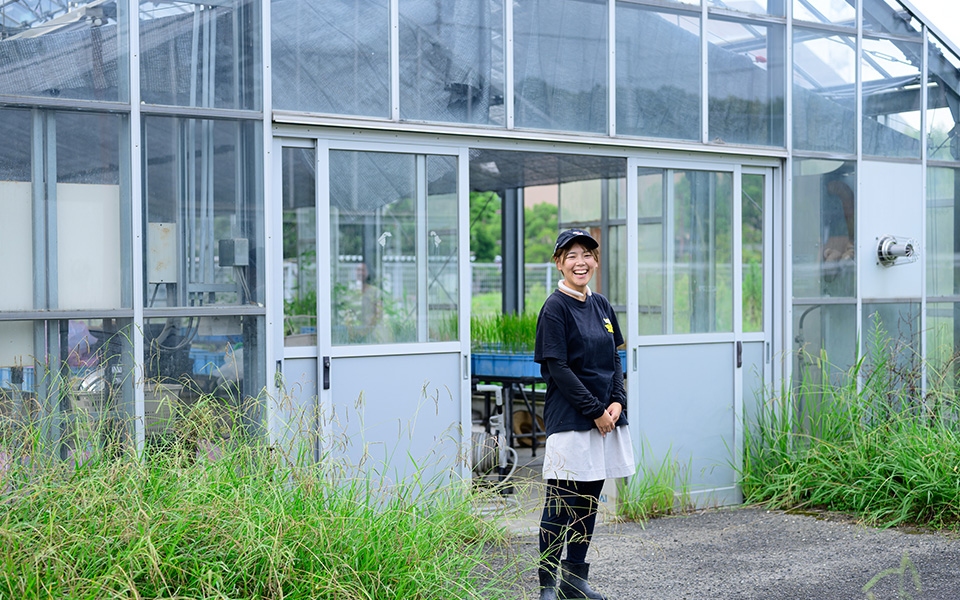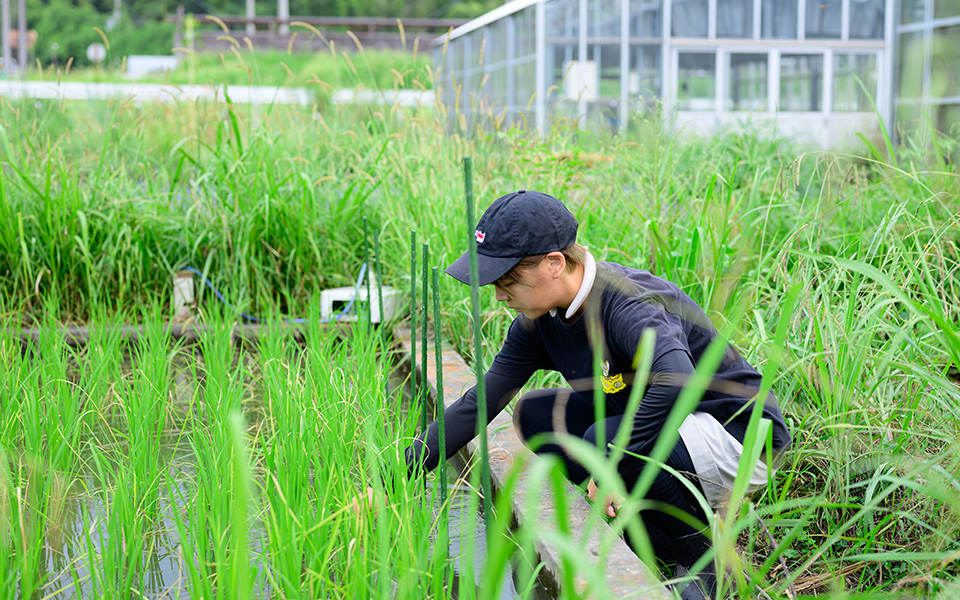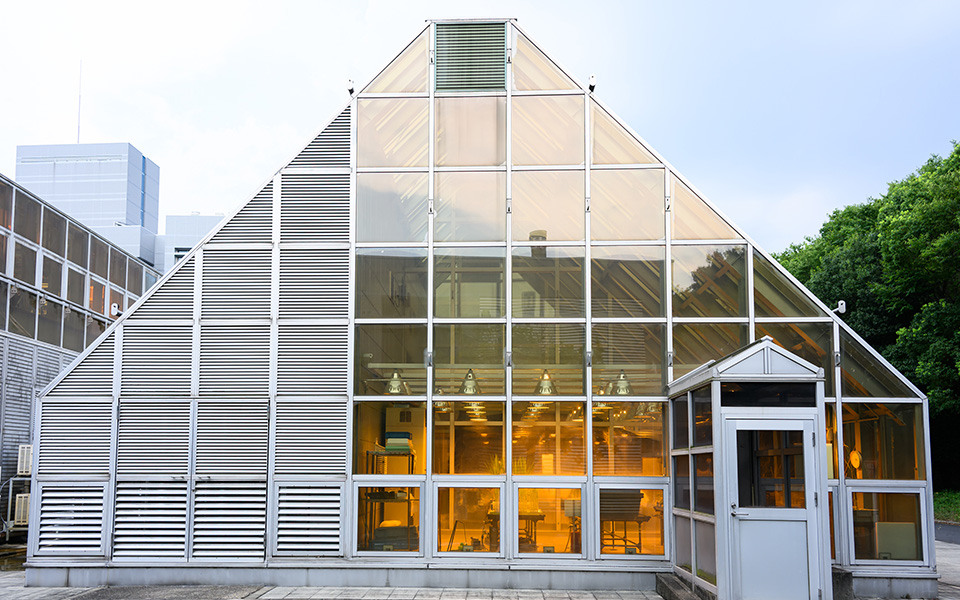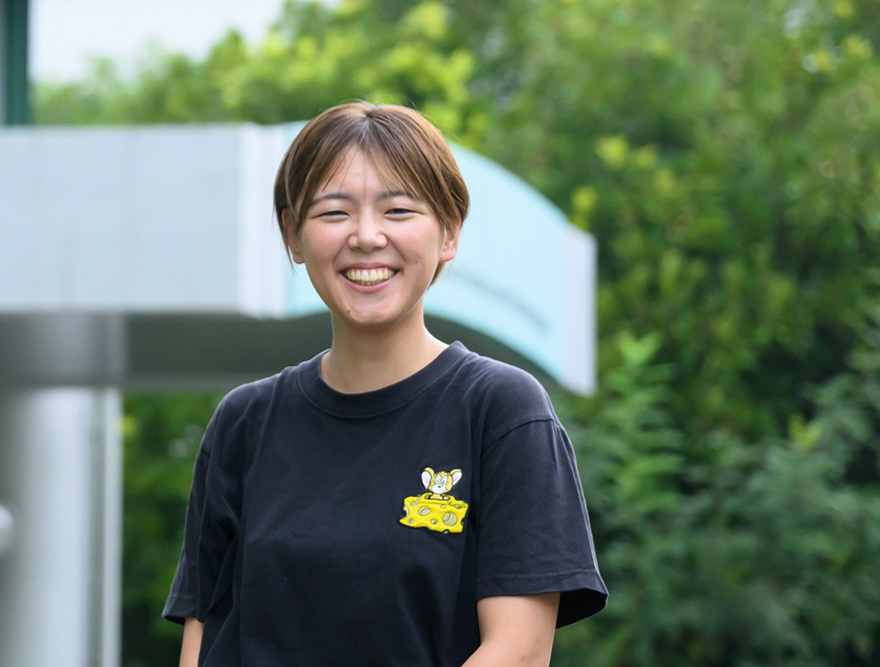Before Entering NAIST and Founding GRow Inc.
I'm from Shimonoseki City in Yamaguchi Prefecture. With fisheries being so close to home, I initially planned to go to a university where I could study fisheries. However, I ended up enrolling in the Faculty of Life Sciences at Ritsumeikan University. The most popular lab at the time specialized in soil microbes. While working to join that lab—including activities like creating a farm plot on campus—my interest shifted from fisheries to soil.
Although lab admission wasn't possible until my fourth year, I wanted to start something and believed I could contribute outside the lab. So, I formed an independent study group and asked the professor from the soil microbiology lab to serve as our advisor. In the fall of my first year, we rented land on campus and cultivated it during my second year. I served as the representative for this group of about 20 people.
After joining the lab, I began research to visualize how soil quality affects crops. This work was based on the premise that higher total soil microbial biomass, as measured by environmental DNA, creates a better environment for crops. However, as the research progressed, I realized that the total biomass of soil microorganisms alone does not determine the impact on crops. Wanting to examine the responses between microorganisms and plants more closely, I decided to pursue my master's degree in the Plant Immunology Laboratory (hereafter referred to as the Saijo Lab), which studies symbiotic bacteria in rice.

Meanwhile, I had been interested in entrepreneurship since my undergraduate days. Ritsumeikan University has the EDGE+R program, which is the same type of initiative as NAIST's GEIOT project funded by the Ministry of Education, Culture, Sports, Science and Technology (MEXT). Having taken EDGE+R at Ritsumeikan, I was familiar with GEIOT even during my undergraduate years. I believe it was through GEIOT that I encountered NAIST. After entering NAIST, I participated in GEIOT and established GRow Inc. during my second year. GRow tackles challenges like the shortage of successors, the increase in abandoned farmland, and soil degradation. We operate rental farms and plan agricultural experience events. Currently, we have two bases in the Yoshino District in Nara Prefecture.
After completing my master's program, I joined former NTT Communications Corporation as a new graduate and worked in Tokyo for two years and ten months. While involved in developing tourism apps, I tried to launch an agriculture-related business using the company's internal venture system from my first year, but it didn't go well. During my GRow activities, farmers often asked me to explain things in more detail when they learned I had researched soil microorganisms and symbiotic bacteria at university and graduate school. I realized my current knowledge wasn't sufficient to convey information accurately to farmers, leading me to decide to return to graduate school, which brings me to where I am now.

Current Research and Life as a Graduate Student
After entering the doctoral program, I've been researching the development of symbiotic microbial materials for rice. The paddy fields surveyed by the Saijo Lab for symbiotic microbes have maintained yields at about 60-70% of fields using fertilizers and pesticides (hereafter, fertilized fields), despite having no fertilizers or pesticides applied for over 70 years (hereafter, non-fertilized fields). During my master's studies, I hypothesized that different symbiotic bacteria were active in the no-fertilizer field compared to the fertilized field. I analyzed these differences and investigated the pathways used within the rice plant to establish symbiosis. Subsequently, during my time working outside academia, the Saijo Lab collected numerous bacteria that promote crop growth. Currently, we are developing microbial materials by blending fungi with different characteristics so that farmers in other regions can also utilize them. We are cultivating seedlings inoculated with these symbiotic fungi in the fields of farmers associated with GRow, using this as a practical application site for our applied research.
This applied research has three main goals. First, increasing farmers' income by boosting yields with new materials. Second, as global warming changes the environment and production areas shift northward, crops themselves must become more resilient—and we aim to achieve this using natural forces rather than genetic modification. Third, we want to shorten the period it takes for new farmers to stabilize their yields. Currently, those relying on intuition can take years to achieve consistent results, but using this material could accelerate that stabilization.
I hope to live my life involved in agriculture. When I say ‘involved in agriculture,’ becoming a farmer is one path. However, my family aren’t farmers, and I don't own land. Children of farmers find it easier to enter farming, and in some regions, non-farmers must undergo three years of apprenticeship before being allowed to start farming. Therefore, it's faster for someone already in a position to become a farmer to do so than for me to become one. So, what can I do? Since my undergraduate days, I've been able to conduct research, and there aren't many people with a science background in farming. What I can do is give back to agriculture through my research.

I'd always thought humans were hurting the Earth through global warming or environmental destruction. Being human myself, I wondered if coexistence with nature might be impossible. But when I made a farm bed as an undergraduate and practiced organic farming there, I grew food for myself while considering the environment. That's when I realized agriculture might be a way to coexist with nature. It was when I was 19. When I made that farm bed and harvested summer vegetables like tomatoes and corn, I thought, “Well, they actually grew, didn't they?” That moment of wonder, “Oh, we actually grew tomatoes,” is still the most profound feeling I've experienced in my life so far. That's why I want to stay connected to agriculture.
Basically, from Monday to Friday, I commute from the dorm to the lab to do experiments. Evenings are spent preparing materials. Weekends involve my company activities or working as a research assistant for GEIOT. At the company, I often organize networking events at our base. Since I enjoy interacting with people, it feels like a blend of leisure and work.
For the future, I want to stay in Nara while continuing with my company. I aim to implement the materials I'm currently developing in actual farming settings and turn it into a business within three years. I've traveled solo to all 47 prefectures and moved about six times so far. Nara feels like the place with the most people living diverse lives—artists, guesthouse owners, people with two bases, and so on. Before meeting them, I assumed I'd become a company employee after graduating and work there forever. But I learned many people choose different paths. I rarely hear Nara locals badmouth the place, and even those who left often return—it feels like everyone truly loves Nara. They cherish their hometown and embrace diverse lifestyles, which is how I want to live too. That's why Nara feels like a comfortable place to be.
Research Environment Challenges
I feel our university has many strengths, but if I had to point out a drawback, it would be accessibility. Having a car makes things manageable, but shopping is inconvenient and it's far from the nearest station. During my master's program, I'd hitch a ride with friends who had cars, especially when they were going shopping. When I returned for my doctoral program, I knew “I need a car to live as a student at NAIST,” so I bought one.
The biggest strength is probably the extremely affordable dormitories. While there might be some inconveniences, they are perfect in terms of price. I was selected for the NAIST Granite Fellowship for doctoral students, so I have almost no living expenses or tuition costs.
I also think the large number of faculty and staff provides excellent support. At universities with undergrads and large student populations, instructions can feel overwhelming, but as a graduate-only institution, that's absent here, allowing for focused research. During my undergraduate years, with so many students, proactive individuals tended to be overlooked by faculty. I sometimes found myself going down the wrong path without realizing it, so I wanted proper instructions and someone to help me set my direction. In that regard, here there's always an environment where you can ask questions. I've been interested in entrepreneurship since starting my master's program, and Professor Saijo has been supportive of that from the beginning. I felt it was easy to consult with him and build a trusting relationship. I think NAIST has the capacity to truly see each individual student.



